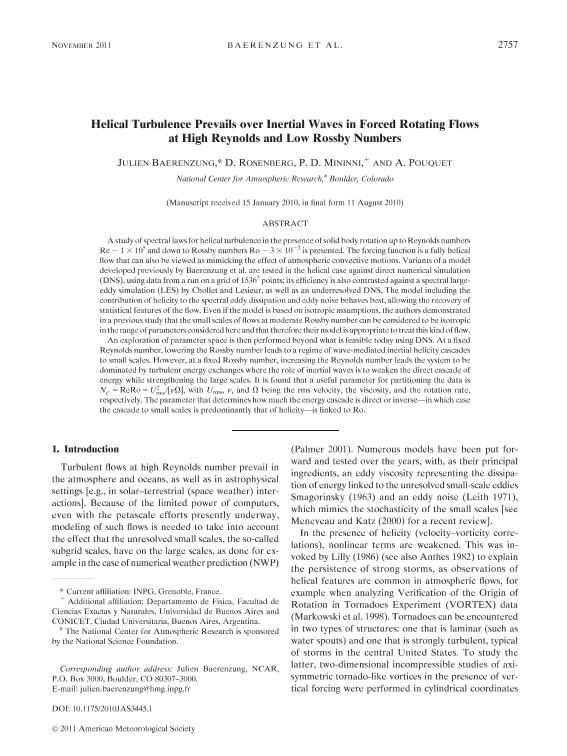Mostrar el registro sencillo del ítem
dc.contributor.author
Baerenzung, Ulien
dc.contributor.author
Rosenberg, Duane

dc.contributor.author
Mininni, Pablo Daniel

dc.contributor.author
Pouquet, A.
dc.date.available
2018-08-23T14:23:10Z
dc.date.issued
2011-10
dc.identifier.citation
Baerenzung, Ulien; Rosenberg, Duane; Mininni, Pablo Daniel; Pouquet, A.; Helical turbulence prevails over inertial waves in forced rotating flows at high reynolds and low rossby numbers; American Meteorological Society; Journal of The Atmospheric Sciences; 68; 11; 10-2011; 2757-2770
dc.identifier.issn
0022-4928
dc.identifier.uri
http://hdl.handle.net/11336/56752
dc.description.abstract
Astudy of spectral laws for helical turbulence in the presence of solid body rotation up to Reynolds numbers Re ~ 1 × 105 and down to Rossby numbers Ro ~ 3 × 10-3 is presented. The forcing function is a fully helical flow that can also be viewed as mimicking the effect of atmospheric convective motions. Variants of a model developed previously by Baerenzung et al. are tested in the helical case against direct numerical simulation (DNS), using data from a run on a grid of 15363 points; its efficiency is also contrasted against a spectral largeeddy simulation (LES) by Chollet and Lesieur, as well as an underresolved DNS. The model including the contribution of helicity to the spectral eddy dissipation and eddy noise behaves best, allowing the recovery of statistical features of the flow. Even if the model is based on isotropic assumptions, the authors demonstrated in a previous study that the small scales of flows at moderate Rossby number can be considered to be isotropic in the range of parameters considered here and that therefore theirmodel is appropriate to treat this kind of flow. An exploration of parameter space is then performed beyond what is feasible today using DNS. At a fixed Reynolds number, lowering the Rossby number leads to a regime of wave-mediated inertial helicity cascades to small scales. However, at a fixed Rossby number, increasing the Reynolds number leads the system to be dominated by turbulent energy exchanges where the role of inertial waves is to weaken the direct cascade of energy while strengthening the large scales. It is found that a useful parameter for partitioning the data is NC = ReRo = U2rms/[vΩ], with Urms, ν, and Ω being the rms velocity, the viscosity, and the rotation rate, respectively. The parameter that determines how much the energy cascade is direct or inverse-in which case the cascade to small scales is predominantly that of helicity-is linked to Ro. © 2011 American Meteorological Society.
dc.format
application/pdf
dc.language.iso
eng
dc.publisher
American Meteorological Society

dc.rights
info:eu-repo/semantics/openAccess
dc.rights.uri
https://creativecommons.org/licenses/by-nc-sa/2.5/ar/
dc.subject
Model Comparison
dc.subject
Numerical Analysis/Modeling
dc.subject
Turbulence
dc.subject.classification
Astronomía

dc.subject.classification
Ciencias Físicas

dc.subject.classification
CIENCIAS NATURALES Y EXACTAS

dc.subject.classification
Meteorología y Ciencias Atmosféricas

dc.subject.classification
Ciencias de la Tierra y relacionadas con el Medio Ambiente

dc.subject.classification
CIENCIAS NATURALES Y EXACTAS

dc.title
Helical turbulence prevails over inertial waves in forced rotating flows at high reynolds and low rossby numbers
dc.type
info:eu-repo/semantics/article
dc.type
info:ar-repo/semantics/artículo
dc.type
info:eu-repo/semantics/publishedVersion
dc.date.updated
2018-08-21T14:28:05Z
dc.journal.volume
68
dc.journal.number
11
dc.journal.pagination
2757-2770
dc.journal.pais
Estados Unidos

dc.journal.ciudad
Boston
dc.description.fil
Fil: Baerenzung, Ulien. National Center for Atmospheric Research; Estados Unidos
dc.description.fil
Fil: Rosenberg, Duane. National Center for Atmospheric Research; Estados Unidos
dc.description.fil
Fil: Mininni, Pablo Daniel. National Center for Atmospheric Research; Estados Unidos. Universidad de Buenos Aires; Argentina. Consejo Nacional de Investigaciones Científicas y Técnicas. Oficina de Coordinación Administrativa Ciudad Universitaria. Instituto de Física de Buenos Aires. Universidad de Buenos Aires. Facultad de Ciencias Exactas y Naturales. Instituto de Física de Buenos Aires; Argentina
dc.description.fil
Fil: Pouquet, A.. National Center for Atmospheric Research; Estados Unidos
dc.journal.title
Journal of The Atmospheric Sciences

dc.relation.alternativeid
info:eu-repo/semantics/altIdentifier/url/http://journals.ametsoc.org/doi/abs/10.1175/2010JAS3445.1
dc.relation.alternativeid
info:eu-repo/semantics/altIdentifier/doi/http://dx.doi.org/10.1175/2010JAS3445.1
Archivos asociados
